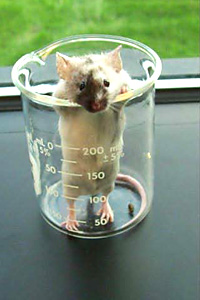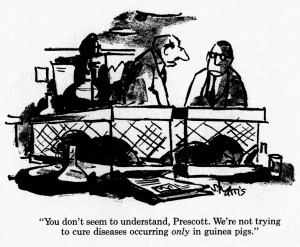Eldorado Desperadoes I: Of Mice and Men
 About a week ago, the Internet went wild with the announcement that a “fountain of youth” drug had been found that extends life by about 10%. I picked a site at random and read the report, knowing full well what I would find buried somewhere in the story. Sure enough, there it was, tucked at the end of a paragraph halfway down: the study was done on mice.
About a week ago, the Internet went wild with the announcement that a “fountain of youth” drug had been found that extends life by about 10%. I picked a site at random and read the report, knowing full well what I would find buried somewhere in the story. Sure enough, there it was, tucked at the end of a paragraph halfway down: the study was done on mice.
The “elixir of life” is rapamycin, an immunosuppressant used to prevent transplanted organ rejection. The maximum human daily dose for rapamycin is 5 mg. To receive the same relative amount as the mice were fed in the study, people would have to ingest 200 mg daily. This means that anyone who takes “longevity” doses of rapamycin had better live in a controlled, sterile environment. It also means that they’ll be prone to developing tumors. This is not a problem for mice, in whom cancer can be easily cured. Not so, by a long shot, for humans.
Mice are extremely useful for dissecting molecular pathways and fairly useful as models for a long list of diseases. Their advantages are many and obvious: they’re mammals, so they share more with humans than the other organisms used in genetics – yeast, flies, worms, fish. Their generation times are short, their litters large. We can totally control their environment, though this affects their health and behavior. We can alter, delete or insert genes in mice and regulate when and where they express. And mouse research is far less emotionally and ethically fraught than experiments on primates.
However, as I never tire of saying, the devil’s in the details. Mice are sufficiently different that drug studies, in particular, are better as proofs of principle than one-on-one mappings. Unlike us, mice are fast-metabolizing and short-lived. Drugs, nutrients and hormones are radically divergent in every mammal in terms of bioavailability, activity, metabolism and toxicity. Many drugs that showed exceptional promise in mice fared no better than placebos or essentially acted as poisons in human clinical trials. The social and behavioral wiring of the two species are totally disparate. For example, mouse sexual arousal and mothering behavior depend on smell pheromones. Mouse models of complex diseases are prone to over- or mis-interpretation. Does a compound stop a mouse from jerking uncontrollably because it’s a pain killer — or is it acting as a muscle relaxant? It’s even harder to correlate such complicated responses as learning, anxiety or depression.

At the molecular level, many genes that are essential in mice are non-essential in humans and vice versa. Comparisons between the human genome and its recently completed mouse equivalent show that they diverge far more than previously recognized – close to 20%. Not only are there significant numbers of human-specific genes; equally importantly, genes whose structure is identical in the two species are nevertheless differently regulated. And last but decidedly not least, the two species have distinct regulatory RNAs (miRNAs for the truly curious).
All this may sound esoteric, but the conclusion is simple: mouse models, especially those based on highly inbred strains, recapitulate only limited aspects of many human functions and diseases. This is particularly true of metabolism, neoplasty, lifespan and that troublesome jewel in the crown – the brain. Elixirs and panaceas for obesity, cancer, longevity and dementia remain stubbornly species-specific. So next time a brushfire sweeps the Internet with news of yet another miracle cure, the first and last question of non-biologists should be: what were (or when will we know) the results of the human tests?
Cartoon: Sidney Harris, What’s so Funny about Science?
The saga continues on H+ Magazine: Eldorado Desperadoes II, The Quantum Choice: You Can Have Either Sex or Immortality


Do you think the extensive use of mice as test subjects could also lead to the abandonment of potentially useful therapies? For example, basing the viability of a drug or treatment on it’s ineffectiveness in mice where it may have been effective in humans.
I wish I had an Athena analysis for every brush fire, thanks.
Yes, Odin, that might very well happen. The profit motive of the pharma industry, combined with the stringent safety codes for human testing, ensure that essentially nothing is first tried on humans. At best, it’s tried on Rhesus monkeys.
There are other tests for toxicity (the Ames among them), but none are perfect. For example, nitroglycerine registers as toxic in the Ames test. The outcome of all this is that only a tiny subset of potential therapies makes it to human clinical trials. Exceptions occur when people are truly desperate — for example, the AIDS activists forced the anti-HIV compounds through the pipeline at preternatural speed, and started taking them even when they were at the experimental stage.
Also, it’s a very little known fact that human studies routinely last six weeks (!). Very rarely do we get real long-term follow-ups. Those are invariably done by those routinely vilified government instutitions, like the NIH.
I am not sure of the ethics behind my position. But if I was diagnosed with a terminal condition I would have absolutely no qualms with taking compounds that are not fully tested if their was even a remote chance there positive aspects would outweigh the negative.